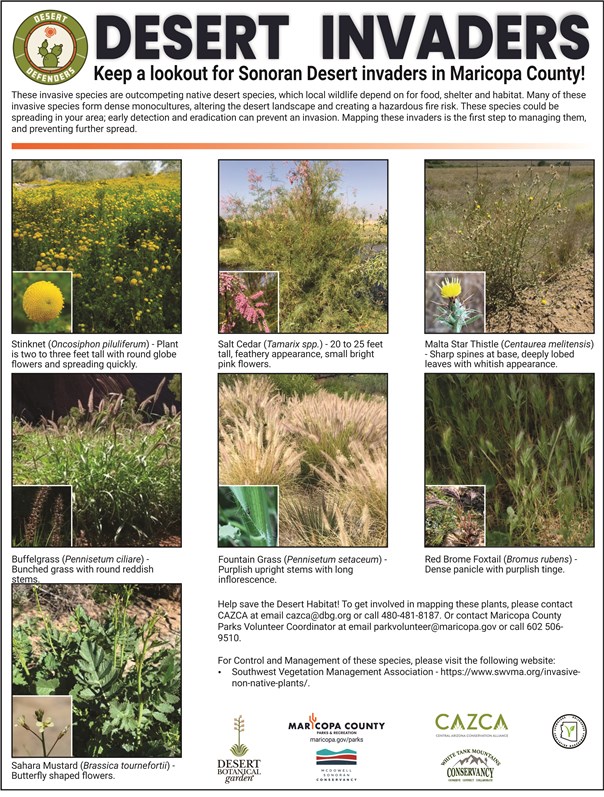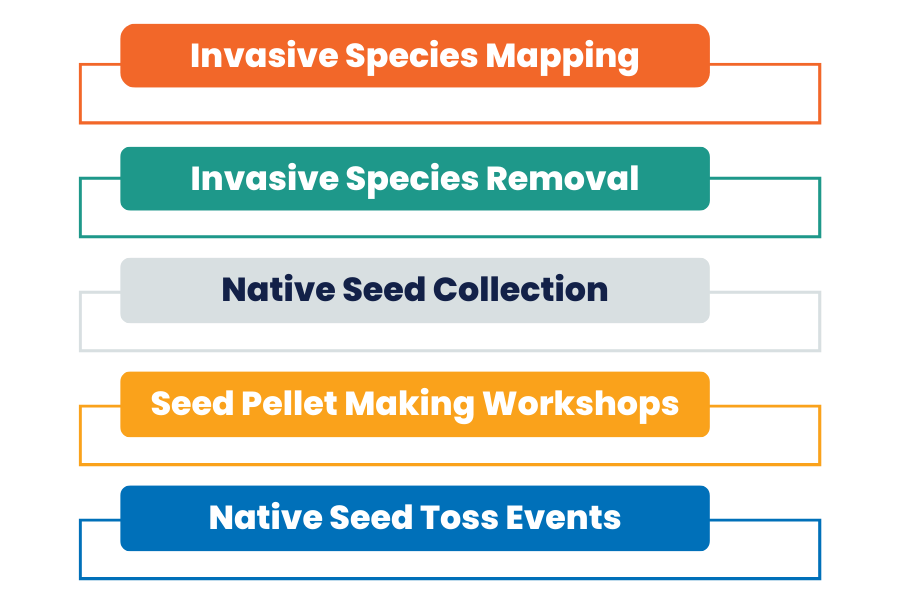The Desert Defenders program is a powerful collaboration, uniting citizen scientists, the Central Arizona Conservation Alliance, the Maricopa County Parks and Recreation Department, and agencies such as the White Tank Mountains Conservancy, McDowell Sonoran Conservancy, and others.
Thanks to the dedication of our citizen scientists, the program is making significant strides in improving the region and parks' native biodiversity and ecosystem health.
The agencies are currently focusing on the most problematic desert invaders as they:

- Provide fuel for wildfires, increasing wildfire frequency and magnitude.
- Outcompete native plants that wildlife needs to thrive.
- Alter ecosystem health
The Desert Defender program includes five steps:

Our Invasive Species Mapping process is a crucial tool that helps the parks better understand the spread of invasive species and where to focus our resources. Using a smartphone app, we map invasive species and document their relative abundance and life stage. When treated, we provide treatment methods and the area covered to the mapping tool, which aids in effectively managing invasive species.
Subsequent removal of these invasive species is not only necessary but crucial for reducing and managing them, as they fuel our wildfires, alter the park's ecosystem, and outcompete native plants.
Invasive Species Removal. The department prioritizes the treatment areas, as we have over 120,000 acres to manage; using best management practices and treatment methods to manage invasive species, our Desert Defenders physically or mechanically remove invasive species in areas that have been prioritized based on the invasion abundance and the quality of the natural area. When prioritizing, we also consider how likely the seed can be spread to a new location, as they can easily be picked up on clothes, shoes, and equipment and transferred to other areas of the park. We also work with contractors to treat areas with dense invasive species abundance by using herbicide treatments.
Native Seed Harvest Collection. Once the native plant seeds have formed, we harvest them, process them (remove the chaff), and then store them appropriately. We are harvesting resilient seeds that will do better as they have adapted to this environment and the local climate. We use sustainability measures to ensure we do not over-collect over-collect seed by only taking a small percentage from each species and population; this varies by life cycle and plant type.
We then turn the seed into pellets during our Seed Pellet-Making Workshops. Mixing clay, compost, native bacteria, and fungi helps protect the seeds until the winter rains. Then, they will have the necessary nutrients to germinate and thrive in the desert landscape after being sown into the desert in the fall.
During the fall Native Seed Toss Events, we meet to throw seed pellets into parks' invasive species-treated and wildfire-impacted areas. This gives the pellets a chance to benefit from the winter rains and establish roots, which help stabilize the soil, reduce erosion, and provide a habitat for local wildlife. This strategic planting is beneficial as it deters invasive species from returning, prevents future wildfires, and contributes to the health and sustainability of the park ecosystems.
The Desert Defender Program participants will learn how to identify and remove invasive species, how to identify native plants while in flower and seed, and how to harvest and process native seed; they will better understand ecosystem health, how to make seed pellets, best management practices for sowing seed, and much more! They will become knowledgeable about our natural areas and the need to preserve, conserve, and restore them by joining us for Desert Defender Events and becoming part of the Desert Defender Community.
We always need more help to make this program a success! We currently host events at several regional parks, including Cave Creek, Estrella Mountain, Usery Mountain, McDowell Mountain, San Tan Mountain Regional Parks, and Spur Cross Ranch Conservation Area, and we need your help! To become a Desert Defender Volunteer, please email parkvolunteer@maricopa.gov.
If you would like to help at any of the events, please register for them using the links on the flyer(s).
Volunteers participating in four Desert Defenders events in the same year will receive a Desert Defender T-shirt.
Parks works with several federal, state, and local agencies and volunteers around the valley to protect the natural resources in Maricopa County's regional parks.
Maricopa County's Emergency Management Department frequently assists in providing Parks and the public with information when emergency situations such as wildfires and floods occur within the park(s).
In 2023, more than 2,000 acres at McDowell Mountain Regional Park were scarred by the Diamond Wildfire. What happens to the natural resources in the park when they're impacted by a wildfire? Join our natural resource specialist and Emergency Management's team to find out.
Video courtesy of Maricopa County Emergency Management.